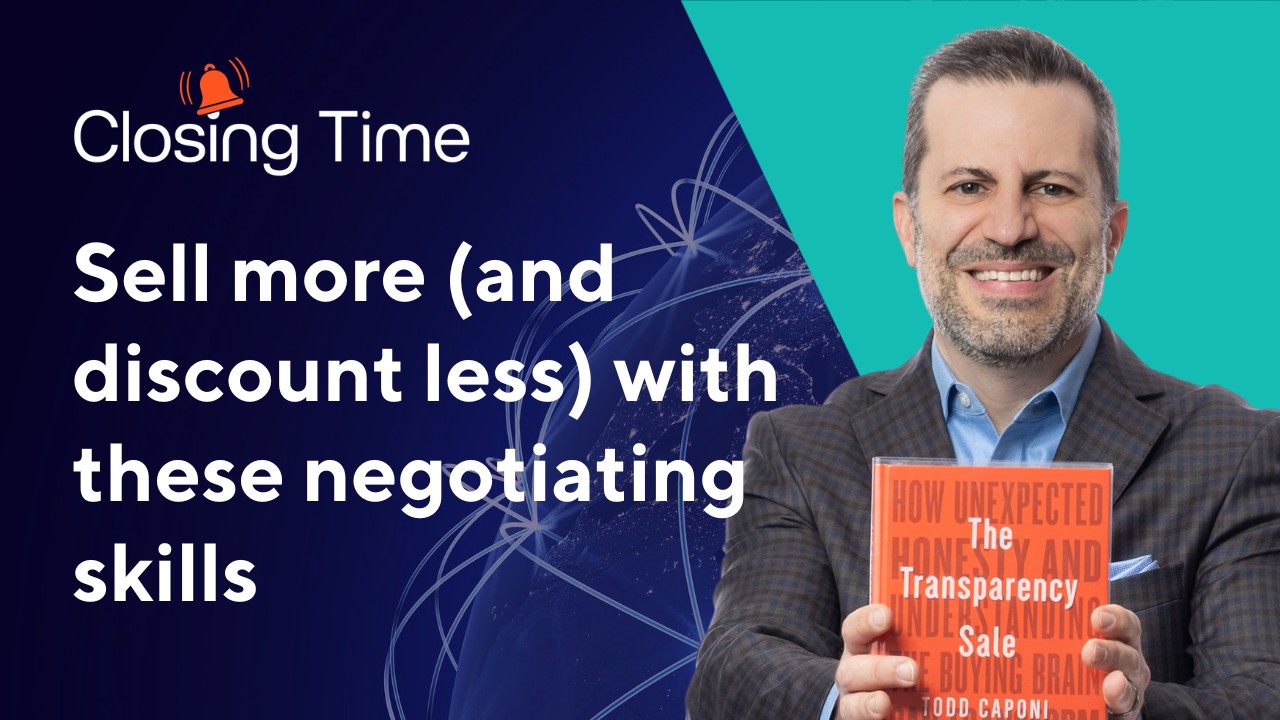Are you and your team fighting the urge to discount? We’re going to talk about where it comes from and what to do about it in this week’s episode of Closing Time. Hello, friends, and welcome to today’s episode of Closing Time, the show for go-to-market leaders. My name is Chip House. I’m the CMO at Insightly CRM. And today, I’m joined by Todd Caponi, author of the book, The Transparency Sale. He’s also a speaker and a consultant in the field of sales. Welcome, Todd. Thanks for having me. It’s a subject I can’t wait to dig into. So, Todd,. I love to talk with you about negotiation. And you’ve talked about how sometimes negotiation feels like it’s a hostage situation. Really interesting concept. Can you dig into that a bit? Well, I don’t know if it really when we think about negotiating. I always thought growing up in sales that it seemed weird that I needed a different personality to negotiate than I did to sell. For anybody who’s listening to this, you probably feel that where you build a relationship with the buyer, you take them all the way to the goal line. They say, we’re ready to move forward. And you subconsciously go into this, hey,. I’m going to start lying to you. I’m not going to tell you what a good deal is. I’m going to try to get the most out of you that I possibly can without giving anything away. And oh, by the way,. I learned my techniques from former FBI hostage negotiators, which tend to be the ones that have written a lot of the books on negotiating. That always felt weird to me. And at its core, I think that that’s one of the reasons why we’re eroding trust at the goal line instead of building it, which seems crazy to me. We’re eroding deal values at the goal line instead of building them. And we don’t get to tase the buyer after they close the deal and drag them off to jail. In today’s era where everything is as a service, the deal is the beginning of the relationship, not the end. And I think it calls for a changed lens in the way that we think about sales negotiating. Obviously, one of the top considerations when buying something for the buyer is, hey, how much is this going to cost? Right. And so how do you deal with that sort of tension that sort of exists when you start talking to a potential buyer? Well, there’s a couple of things. You know, first of all, one of the things that is about this idea of negotiating transparently and how you can change it. And this is really easy. So everybody who’s listening just grab a pen and write these things down real quick because it’s super easy like it used to be known, Chip, I don’t know if you remember this, at ExactTarget. It was once known as Todd Caponi’s famous 20 minute negotiation skills class because it literally takes 20 minutes to teach. But it’s this idea that for your company and every for profit company in the world, your pricing and your whole organization is driven by four things. Number one is volume, how much they buy when you want them to buy more. That’s better for you. Number two, probably like money, right? Number two, is the timing of cash. The faster that the companies pay you, the better it is for you. Number three, length of commitment, longer commitments, better, shorter commitments. Not so good, right?. So length of commitment. The fourth one is the timing of the deal or your ability to forecast, to resource, to get investments based on a forecast. Those are the four things how much they buy, how fast they pay, how long they commit, and when they sign. Why can’t you start a conversation by sharing that that when a customer’s asking you how you price, you can tell them, hey, our pricing is based on this volume component. And as it turns out, the more you buy, the better the price is going to be. And the way that we price is based on, you know, annual upfront net 30. And it requires a commitment. As you get down into negotiating, now you’ve given the buyer the cards to be able to negotiate their own deal, right? They want a discount. Absolutely. Right. Hey, listen, we understand there’s a few ways we can get you there. Commit to more, pay faster, commit longer or help us forecast. Right. It’s a cards face up approach that again builds trust to the goal line, gets you value for every dollar you give away in the form of a discount. And in the end, if you play that fourth lever right, it’ll make your deals more predictable overnight. So the cards all face up is exactly the opposite of what you typically hear about negotiating. You typically hear never talk first. Right. And so what’s your answer to that? Well, I’ll tell you,. I mean, there’s a lot of research. There’s behavioral science that I’ve read that I’m like, yeah, of course. But there’s actually been some research out of the University of Texas that talks to this idea that goes, you know, 180 degrees from how we all brought up or were brought up in sales that the way that I was brought up in sales and this is actually a quote, I’m a huge sales history nerd, as you know, there’s a quote from like the 1920s that says “don’t tell the customer the price until they think it’s more” like, that’s gross, right? I believe in today’s era, with the proliferation of information and this idea of doing the homework for the buyer, that we should start leading with our price and set a range for the customer. Use that as an opportunity to qualify in or qualify out that you picked research from the University of Texas at Austin that came out last October really reinforces this idea that as it turns out, when we do lead with price, magic happens. Customers are more likely to buy, more likely to stay, more likely to buy more and more likely to advocate. And again, if we’re going to lose lose fast and one little extra piece on that, if you’re talking about a six figure solution to a four figure buyer, one of you is in the wrong conversation, wouldn’t you want to find that out soon? Right. And that’s part or vice versa. If you’re talking about a four figure solution to a customer that’s expecting six, vet that out early. So I’m a huge advocate in not only being transparent in what drives your business because it’s probably what drives your buyer’s business but leading with that price set a price expectation via a range and no surprises and you’ll build trust with the goal line. You’ll have customers that are negotiating their own deals and you’re not eroding any value along the way. So it’s really interesting. So introducing price as the salesperson proactively in the conversation that just takes away some of the potential objections and friction. Well, yeah, absolutely. I mean, imagine walking in and telling a customer like, Hey, listen, before we get too deep into this, especially if you’re a premium solution to walk into a situation and say, Hey, listen, before we get too deep into this, based on our understanding of your environment and your needs and your user count or whatever, your price is probably going to be between X and Y. Now, if we’re way off on that, let’s address that now. Right. And like I do that in my business, you know, I speak, I teach, I do workshops. I’m constantly telling customers like, hey, before we get too deep into this and figure out what the content looks like, here’s my rates. And if that’s going to give you a ton of heartburn, let’s address that right now. The amount of times that it has given heartburn yeah, there’s been a few and they’re like, hey, we’ve got to probably rethink this or think of another way to get other people involved or, you know, they’re going out and getting more budget or maybe in some cases they’re like,. Wow, you’re really cheap, huh? But you want to vet that now versus vetting it after you just spent, again your most precious time and your inventory, your most precious resource in your inventory is your time. Make sure that you’re vetting this stuff out. But to your point, setting those expectations up front, help you avoid some of the uncomfortable trust eroding things that typically happen in a traditional sales process right at the goal line. Sure. You know, it’s interesting, in a B2B process, there often might be multiple steps, right? There might be interaction with an SDR who’s setting the initial meeting. And then there’s, you know, the quote unquote discovery call. And then there’s other calls and so at what point are you doing that? You know, is it in the discovery call even? Well, I think a lot of it has to do with seeing the world, you know, we talked on another episode about this idea of clinical empathy. Right. Which is being able to see the world through the buyer’s eyes. A lot of times you can sense when they’re trying to figure it out, like we as human beings, we buy when we can predict, not when we’re convinced. Part of that prediction is being able to understand what the juice or what the squeeze is going to be for all that good juice. Right. Is the juice going to be worth the squeeze? If I don’t understand what the squeeze is going to be, it’s very difficult for our brains to process all the juicy goodness. Right. And so being able to just start to recognize when the appropriate time is to share that. And in many cases, it might be the time where you’ve got a good estimate of what that pricing is going to be. That initial SDR interaction, maybe not, but once in AE is involved, then they start to dig in a little bit and they start to understand that they can give a range. Now, if your ranges, hey, for a customer like yours, it’s going to be anywhere from $100 to $1,000,000 like that’s dumb. Like you want to be able to get to a level where you can actually give an estimate that sets an expectation that you know, that you can consistently hit and when you’re ready to do that, the earlier you do that, the better. That’s really the advice. So what would be sort of the corollary to that? So once you’ve done that and I mean, clearly most buyers are involving other people internally in the sales process, they’re probably considering some competitors how do you know if you’re making an impact? How can you tell if you’re moving the sale along? Well, from a negotiation perspective,. I think it’s really through this lens that I don’t know if anybody who’s watching or listening has ever run a marathon. But, you know, a marathon is an event, right? Like Boston Marathon happened recently where you show up, like if you’re running in it, you wake up that morning, you go to the event, you do it. However, none of those people woke up that morning thinking, hey, you know what? There’s a cool event going down. I think I’m going to put my gym shoes on and go run it. Right. Like, you know, seven miles in your toenails would be popping off. The point being a marathon is an event, but it’s really a process and so is negotiation. Now, negotiation as the event,. I think there’s a tremendous opportunity for you to be able to explain over and over to your customer that, hey, listen, our pricing is based on these four things. These are the four things that we’re willing to pay you for in the form of a discount. Right? Commit to more, pay faster, commit longer, help us forecast. Right. But if you haven’t laid that foundation throughout the entire process that this is your price range and the pricing is based on these things, the event becomes a lot harder. It’s not to say that it can’t be done, but that’s really the lens to look through this. If you start to negotiate transparently as an event, it’ll have a huge lift on just the relationship that you have with the customer right at the goal line. But if you lay that foundation early and often, that negotiation becomes a nonevent. So when you can feel like you’re missing the mark, right, where maybe you came in too high or something and it seems like the customer can’t afford what you’re selling, what do you do? Well, there’s a couple of things. I think number one is if the customer is never going to be able to afford what you’re selling, part as friends very quickly, right? Like that’s really the goal if an organization only succeeds through profitability ultimately. And one of the things that we’ve talked about is again, this idea that really so many of our businesses are as a service, right? Software as a service. You know, product as a service. There’s all these different as a service. Your profitability as a business comes further out and no longer is the sale the end of the interaction. It’s really in today’s era, it’s the beginning. Which is why so much of this needs to be thrown out. So if you’re coming across a customer where you’ve been transparent, that transparency builds trust, trust begets trust, transparency begets transparency. When you’re able to lead with, hey, this range is likely what a client like yours is likely to face. And they’re like, whoa, that’s way out of our ballpark. It’s a couple of things that happen. Number one is, again, part as friends very quickly. Number two, could be they still want to work with you because you’ve built trust. And in many cases, even when I do it, it’s, hey, you know, what? That’s a little higher than what I’ve got budget for. But we really want to bring you in here. Maybe we can involve some other people and see if we can find more budget. We just had a client that was able to like because they just had a wrong lens on how much this type of investment would be. Right. In general, like they were way under whoever they got was going to be 2X what they had budgeted. I gave them a little education through the trust that I had built. And sure enough, they were able to go out and secure that budget. So it’s not a deal killer. It just makes you smarter with the way that you’re spending your time. It makes perfect sense. And even when you’re getting the yes right, it’s going to be a multistep process. Right. So that sounds good to me. Can you talk to my CFO? Can you talk to my tech guy? Can you be on a call presenting to my CEO even? Right. And so how does the sales person guide that process? Yeah, from a negotiation perspective, one of the things I was just I taught a workshop yesterday and the company CRO was just like, whoa, whoa, whoa. Like, we should only be negotiating with power. I don’t agree with that. I know that sounds nuts. However, when you lay out your pricing consistently and via the four levers, you actually arm your sponsors to go do the negotiating for you. The number of times that that happens now is pretty amazing. But imagine you’re selling to a sponsor. You’ve educated them on this is our pricing structure, these are the four things that drive that pricing and all of a sudden that sponsor goes to get approval and walks into the CFO’s office and the CFO is like, why don’t you go back and have them sharpen their pencil and get the best deal you can? Now with that in old school will require the sales rep to get on the phone and have the battle or have you just armed your sponsor to be able to say, Hey, you know what? I’ve had that discussion with them. This is the way their pricing structured. And hey, if we’re willing to pay them faster, there’s an opportunity. If we’re willing to commit longer, there’s an opportunity. If we’re willing to commit to more volume, there’s an opportunity, if we’re able to get really tightly aligned and mutually align around timing, they’re willing to pay us in the form of a discount to hold to it. Right? Those are our opportunities. Let’s you and me have that conversation instead of dragging this thing on and getting into the sharpen the pencil conversation. So incredible tool. If it’s consistent and transparent that just arms that entire organization to negotiate their own deal. So as a seller, as a company, really,. I mean, getting pricing right is just critical to your economic growth. Right? And so if you’re a salesperson and you’re continually discounting, especially discounting early on in the sale, you’re ultimately impacting your business right? If you’re negotiating too early, you know, so what is it in us psychologically as a salesperson that makes us want to do that? You know, there’s there’s an analogy. I like to share and it has to do with, like. I live just outside of Chicago. We’ve got a forest preserve right out the back, and I’ve got a whole pile of dogs. Like, I think you’ve got a couple of dogs to right chip? But when the weather’s crappy, like, you know, you’re Minnesota, I’m Chicago weather, it’s not always great. You’re going to walk them. I just want to get it over, right? So there’s a path.. I go the path come right back. I just want to get done. Now, imagine I’m walking that path. I’m just trying to get done. Like, just do your business. Let’s go. And all of a sudden there’s a rock and there’s a little piece of paper sticking out of under it and you kick it over and there’s a $20 bill like, what do you do? You probably look at it and go, you know,. Can I keep this? But now your quick path, even if the weather’s bad, just slow down considerably, because now you’re going end and you’re probably kicking over every rock. It just got slower and the path just got longer. And as a result, that that slows down everything. That’s the irony with the way that we discount and the irony with the way that we give stuff away. The minute you give anything away, ironically, you don’t speed up sales cycles, you slow them down because if it was easy to get something, then, gosh that was easy, what else could I get? Like you’d be an idiot not to ask. And anybody who’s ever bought anything knows that fact. So stop giving away anything for free because you are ironically slowing down deals and instead, this is my pricing, it’s based on these four things. Throw the cards face up and let the buyer negotiate their own deal and it changes the dynamic immediately. You’re going to feel it. Todd, so much great stuff there. I love the concept of how that might impact velocity. You know, when you don’t do it right and would love to talk about deal Velocity,. I’m sure you’ll have an opinion. And anyway, we’re out of time, but thanks for joining us today. Thanks for having me as always. Yeah, of course. Super excited to chat with you again some time and thanks to all of you for watching today, this episode of Closing Time, the show for go-to-market leaders, make sure you subscribe, then hit the bell for notifications so you don’t miss an episode and we’ll see you next time.





